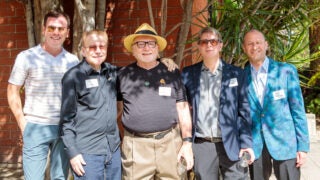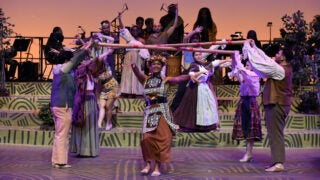
The USC Arts in Action program helps students flex their creative skills to advance inclusivity. (Illustration/Antonio Rodriguez)
Inclusive Student Projects Make Space for Marginalized Communities
USC students use podcasts, performances and workshops to open public platforms for kids and adults.
Juri Hwang MFA ’02 helps people find their voice — literally. A USC doctoral student who studies experiences through sound, she is fascinated by how media and science affect different forms of hearing. Her work has increased her awareness about the everyday challenges of hearing loss — and how many individuals lack support and visibility. “During the pandemic, the hard-of-hearing community suffered a lot due to social distancing,” says Hwang, a doctoral student in media arts and practice at the USC School of Cinematic Arts. “Lip reading became impossible through masks, so bringing some support to this community felt even more urgent.”
She created Here, My Voice, a program to help people with hearing loss reconnect with their voice and build self-confidence. “We saw people blossom in their growth of creativity and expression,” she says. Over several weeks, participants started to break down some of the mental and physical walls that had made them feel isolated, unseen and unheard.
Hwang’s project is just one of many student-led initiatives across campus that use the arts to bring visibility and support to marginalized communities. With financial support from the USC Arts in Action program and the USC Arts and Climate Collective, these projects tap the creative power of singing, drawing and storytelling to drive diversity and inclusion.
USC Student Helps People Rediscover Their Voice
She once sang on Broadway, but today, she can no longer hear. All she wants to do is sing again. That’s what drove the Los Angeles resident to participate in Here, My Voice.
Hwang says this story is just one of the countless experiences that people experience after hearing loss. People struggle to speak and sing out loud but few of those around them know it.
Losing the connection to your voice due to profound hearing loss can be like losing a part of oneself.
Juri Hwang
“Losing the connection to your voice due to profound hearing loss can be like losing a part of oneself,” Hwang says. With funding from USC Vision & Voices’ Arts in Action initiative, she built a team that included a master voice coach, an audiologist, a music therapist and USC Thornton School of Music students. The team partnered with participants from the Hearing Loss Association of America to help them achieve personal goals, like reading poetry aloud or singing a song to an audience. Student teachers provided one-on-one voice coaching and lots of emotional support to help build confidence. Though many participants seemed skeptical at first, it generated stunning results.
“We had many amazing breakthroughs to the extent that we did not think was possible,” Hwang says. Participants felt seen and they built a stronger connection to others experiencing hearing loss and gained confidence, she says.
Hwang hopes that lessons from Here, My Voice will inspire others to recognize the value of inclusion and self-expression in the hard-of-hearing community. “For me, it has been remarkable to see what deep collaboration and care can achieve in making positive impact in other lives.”
USC Students Build Diversity into Arts and Architecture
When does an architect first dream about becoming an architect? For many, someone older probably noticed their interest in buildings or Lego blocks as a child and encouraged them, says Erin Light, a third-year architecture major. But the field is struggling to diversify its ranks, and “this type of awareness of architecture is a privilege largely dependent on race, ethnicity and socioeconomic status.”
As part of a larger initiative to address racial disparities in the field, Light and seven other USC School of Architecture student leaders created the Architecture and Advocacy program. It aims to introduce architecture to children and teens. They teamed up with LA Commons, a nonprofit that offers community-based youth art programs, to involve high school students from South L.A. schools.
“While the general public often associates architecture with the construction of grand monuments and skyscrapers, architecture actually is a very powerful social device which, when employed correctly, can change and improve the lives of many,” says Justin Wan, a fifth-year architecture major and initiative co-founder. The four-week workshop series, funded by Arts in Action, led students through design thinking, problem-solving and reflecting on ways to reimagine their neighborhood through architecture.
The most meaningful lesson that the students learned was the power that they had to change the built environment through creativity and design.
Abriannah Aiken
Students in the online workshops came up with ideas ranging from homeless shelters to green spaces for play. “The most meaningful lesson that the students learned was the power that they had to change the built environment through creativity and design,” says Abriannah Aiken ’21, a co-founder. After a successful first run, the program’s creators — including Katie Hayes ’21 and USC students Darwin Hu, Jameel Marsden, Esmeralda Aceituno and Lauren Jian — hope to offer it again with in-person workshops and field trips to sites around L.A.
Podcasts Spotlight Marginalized Communities
Young people need to feel connected to their community before they’ll invest in making it better, says USC sociology student Irene Franco Rubio. That can be especially hard for young people of color, she says, who are often underrepresented or marginalized.
That’s why Rubio started If You’re Feelin’ Civic, a podcast to share narratives from Black and Indigenous people and people of color in her home state of Arizona.
The goal of this podcast is to create a digital space for historically underrepresented stories and voices to be heard.
Irene Franco Rubio
“The goal of this podcast is to create a digital space for historically underrepresented stories and voices to be heard,” she says. “To create the change our diverse communities need, we need the space to talk about the issues we face in an uplifting and inclusive environment, with young people of color recognizing the power of their voices to lead the conversation.”
Rubio launched the podcast from Phoenix in August and has worked with community transformation groups Arizona Coalition for Change and Our Voice Our Vote Arizona. The podcast will encourage community conversations to engage and empower young people from marginalized communities by helping them learn how to be more civically active, she says.
Also tapping the power of podcasts is Jordy Coutin, who focuses on homelessness and immigration as a doctoral candidate studying public policy and management at the USC Price School of Public Policy. He is working on a two-part podcast that explores the intersection of homelessness, climate and air pollution in Los Angeles. He hopes to give more visibility to people with lived experiences of homelessness and the challenges they face.
Both Rubio and Coutin received funding to launch their podcasts through the USC Arts and Climate Collective.



